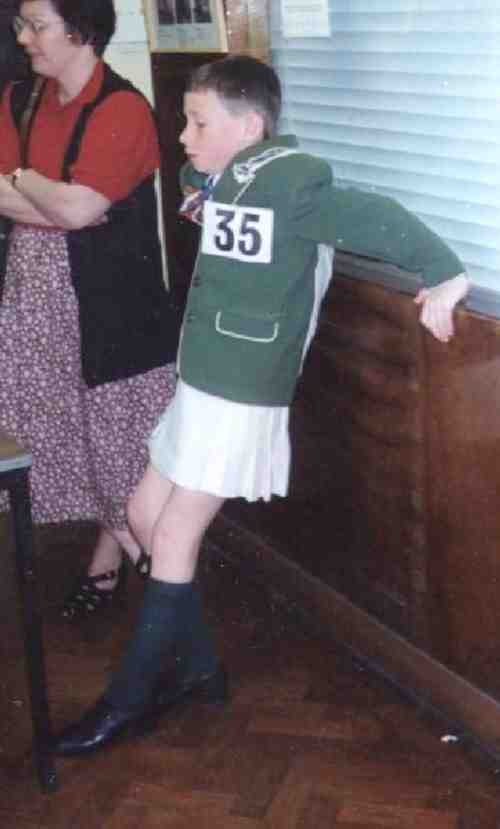
Figure 1.--Irish step dancers wear kilts in many different colors. This boy wears a white kilt. It is shorter than usually worn. Probably mother is about to order a new kilt.


Figure 1.--Irish step dancers wear kilts in many different colors. This boy wears a white kilt. It is shorter than usually worn. Probably mother is about to order a new kilt. |
Boys doing Irish step dancing mostly wore solid colored kilts for competitions, unlike the plaid kilts worn by the boys doing Scottish or Highland dancing. Green
and safron used to be common colors, especially for dancing school uniform kilts. The practice of having the boys at a school all wear the same kilt and jacket is now less common. Individual dancers have a much wider variety of colors. The boys dance in a wide variety of brightly colored kilts as well as white and black ones. At the more advanced levels of competition, almost all of the boys will dance in kilts. The kilts are pleated and vary in length, often because of the mother's tendency due the cost to buy larger sizes.
Boys doing Irish step dancing mostly wore solid colored kilts for competitions, unlike the plaid kilts worn by the boys doing Scottish or Highland dancing. A few boys wear plaid kilts, but HBC has never noted red plaids. The most common appear to be blue plaids. but they are still not very common. A dancer writes, "Boys wear solid color kilts rather than plaid kilts because plaid designed kilts are a Scottish tradition, representing each clan, while Irish clans are represented through solid colors."
[Cipollo]
Green and safron used to be common colors, especially for dancing school uniform kilts. The practice of having the boys at a school all wear the same kilt and jacket is now less common. Individual dancers have a much wider variety of colors. The boys dance in a wide variety of brightly colored kilts as well as white and black ones. Major feis can be quite colorful affairs with the brightly coloted boys' kilts and jackets and the even mpore colorful girls' dancing costumes.
At the more advanced levels of competition, almost all of the boys will dance in kilts. Most Irish dancers wore kilts. Almost all of the boys used to wear kilts, although this varies. Black long pants appears to have common in California, while kilts were more common on the Eastv Coast. Pants have become increasingly common since the advent of River Dance.
The kilts are also pleated. They have a unpleated pannel in front and rgen the back and sides are pleated. The number and size of the pleats vary considerably. This is one of the major signs iof a high quality kilt. The better kilts have more pleats. This means that they are more expensive because heavily pleated kilts require more material. The Irish dancing kilts HBC has seen do not appear to have been as heavily pleated as a good quality Scottis kilt. HBC is not sure why. This may be to keep the cost down. It may be that for dancing, a lighter weight kilt is preferable.
The boys' kilts vary in length, often because of the mother's tendency due the cost of buying larger sizes. Kilts are quite an expensive garments. Thus mothers buy large sizes so that that their often fast growing sons can wear them for a longer period. Some boys dance in these larger new-purchased kilts and continue wearing their kilts even though they may have grown out of them.
Kilts are always made of wool. I'm not sure at this time just what type of wool fabric.
Irish dancing kilts are always worn with kneesocks, even in hot summer weather. Ankle socks are never worn. The colors vary. Like the kilt and jacket, they can be bright colors. A wide variety of colors are worn. Often the kneesocks match the jacket and contrast with the kilt. Occasionally they may be the same color as the kilt. Boys dancing in Ireland or England are likely to wear turn over top socks with a cuff. American boys are less likely to wear the turn over topmstyle as they are less available. A few American boys may even wear cable knit socks.
Cipollo, Kaelyn. E-mail message, August 13, 2004.
Navigate the Historic Boys' Clothing Web Site:
[Main Irish dance costume garment page]
[Introduction]
[Activities]
[Biographies]
[Chronology]
[Cloth and textiles]
[Clothing styles]
[Countries]
[Topics]
[Bibliographies]
[Contributions]
[FAQs]
[Glossaries]
[Satellite sites]
[Tools]
[Boys' Clothing Home]
Navigate the Historic Boys' Clothing Web dance pages:
[Return to the Main Irish step dance costume page]
[Return to the Main Irish step dance page]
[Return to the Main dance page]
[Ballet]
[Highland]
[Ballroom]
[Native American]
[Tap]
Navigate the Boys' Historical Clothing kilt pages:
[Main kilt page]
[Kilt suits]
[Scottish kilts]
[Scottish boys clothing]
[Scottish school uniform]
[Highland dance]
[Irish kilts]
[Irish boys clothing]
[Irish step dancing]
[Greek kilts]
